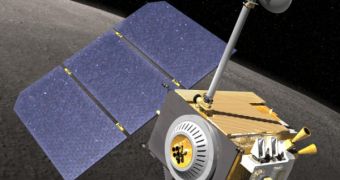The Lunar Reconnaissance Orbiter (LRO) was rolled out on Wednesday from NASA's Goddard Space Flight Center in Greenbelt, Maryland, to the agency's Kennedy Space Center in Florida, on a trip scheduled to last two days. After it was completed, the spacecraft was tested for more than two months in a thermal vacuum tube that faithfully recreated the harsh conditions of outer space. Now, it's being moved to its launch site, from which it's scheduled to take off on April 24th.
The main goal of the LRO is to scout ahead on the Moon, with the purpose of gathering sufficient data to allow NASA to send astronauts back to Earth's natural satellite. The robot is scheduled to spend one full year in low lunar orbit, after which time, if it's still operational, it will pass another three years gathering various reads on the Moon, its surface and its composition from another orbit. During the mission, the space probe is bound to be subjected to numerous changes of temperatures, ranging from hot to freezing, and all the instruments aboard have to cope with these fluctuations.
“This is the culmination of four years of hard work by everyone on the LRO Project. LRO now begins its launch site processing, where it will be prepped for integration with our sister mission LCROSS, and eventually encapsulated in the Atlas V for its journey to the moon,” LRO deputy project manager Cathy Peddie, working at the Goddard Space Flight Center in Maryland, says.
The LCROSS system, standing for Lunar Crater Observation and Sensing Satellite, is designed to impact the Moon's surface and to start searching for liquid or frozen water on the satellite. The Ames Research Center in Moffett Field, California, as well belonging to NASA, is in charge of this device. The Reconnaissance Orbiter itself is due to be given over to the agency's Science Mission Directorate one year after launch, and its new coordinator will use the advanced machine to get a better view of how the Moon is made and what forces still live on its surface.
The polar regions are the most important objective of the whole LRO mission. If the probes manage to discover icy water in the shadowed craters of the northern and the southern shadowed craters dotting the two regions, then a continuous presence of men on the Moon could be ensured, as the polar regions are also lit at all times. In addition to looking for water, the mission will also analyze and chart the topography, lighting conditions, mineralogical composition, and natural resources that could potentially be used in the future for constructing a permanent lunar base.

 14 DAY TRIAL //
14 DAY TRIAL //